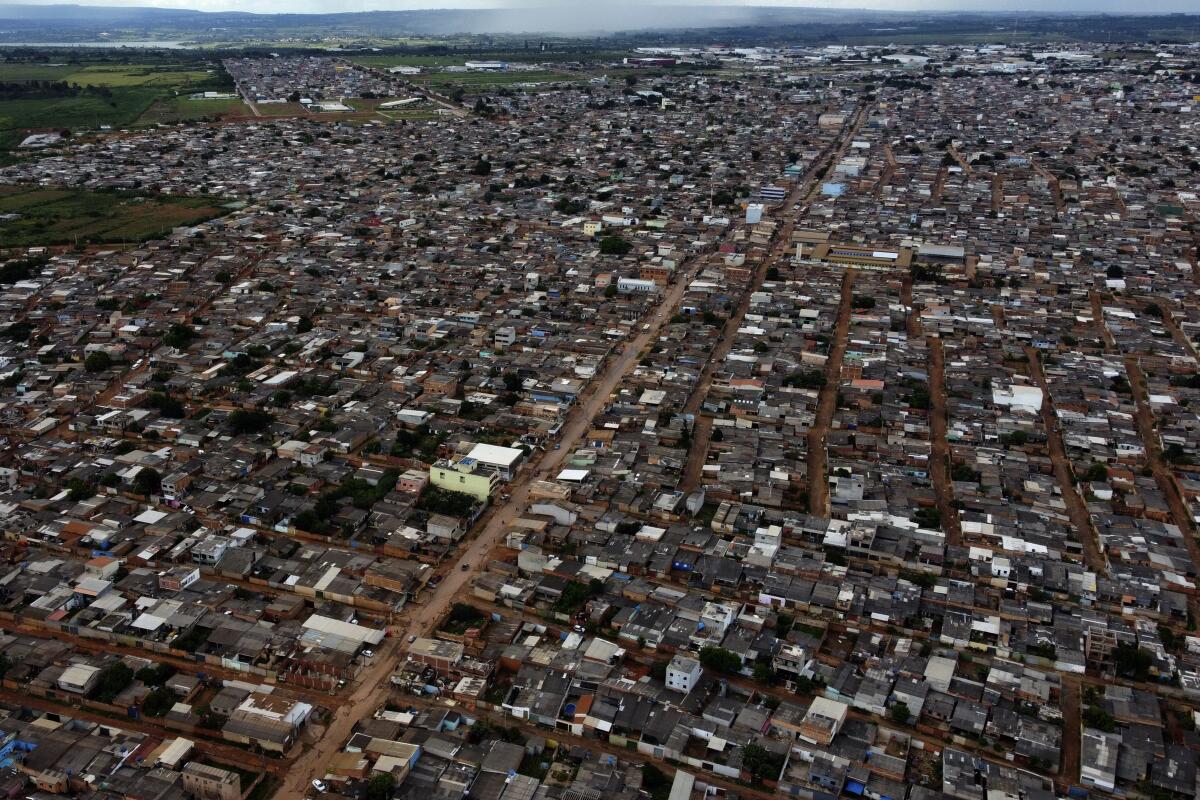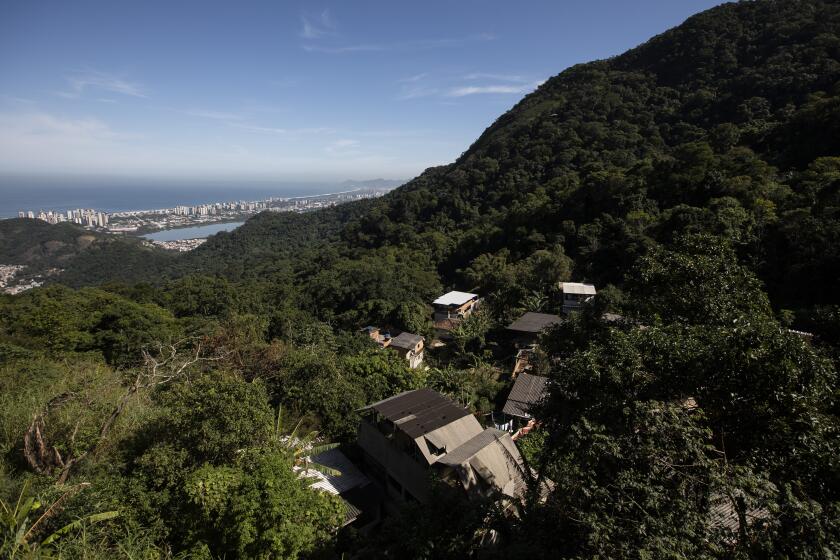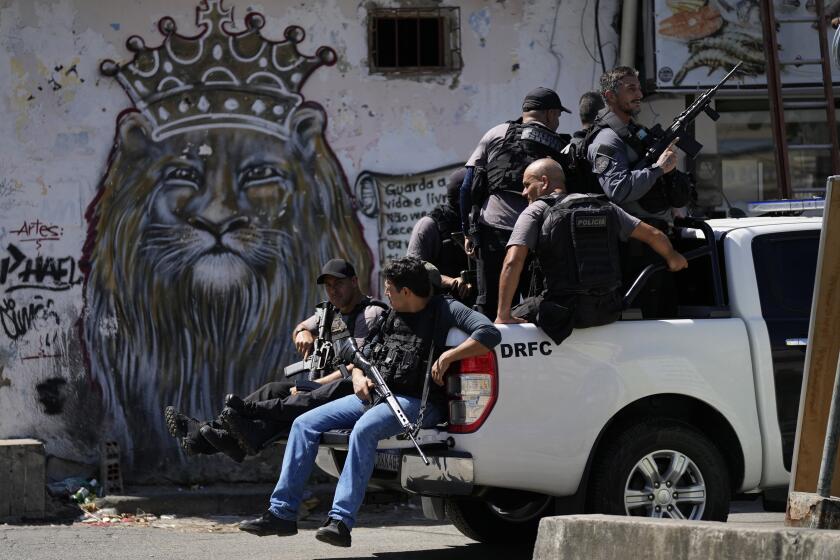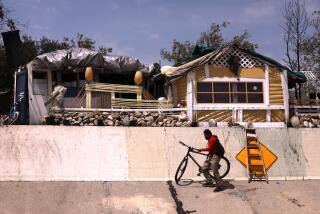Brazil has a new biggest favela, and it’s not in Rio de Janeiro

- Share via
SOL NASCENTE, Brazil — The buzzing main avenue of this poor Brazilian neighborhood is filled with people popping off buses after work or grabbing a bite. Teens attend an open-air rap battle and gymnastics class. Hymns and prayers from tiny church services spill into the night.
It’s an ordinary Wednesday in Brazil’s biggest favela, or low-income neighborhood. And for the first time since poverty, lack of opportunity and economic inequality caused favelas to mushroom across many of the nation’s cities, that superlative doesn’t belong to a favela in Rio de Janeiro.
Sol Nascente (which translates as Rising Sun, in English) is just 21 miles from the capital Brasilia in the Federal District, whose GDP per capita is higher by far than any Brazilian state, underscoring the inequality between affluent public servants’ neighborhoods and the district’s outskirts.
The number of households in Sol Nascente has swelled 31% since 2010 to more than 32,000, surpassing Rio’s hillside Rocinha favela that had been Brazil’s most populous, according to preliminary data from the ongoing census. Rocinha has almost 31,000 households, the data show.
Heavy rain caused flooding and landslides that have killed 36 people on the northern coast of Brazil’s Sao Paulo state.
Along Sol Nascente’s unpaved dirt roads of self-built homes and inside the main strip’s busy stores and restaurants, no one the Associated Press spoke to welcomed the new ranking,
“We still need lots of things, like basic sanitation and infrastructure, but people nowadays have better conditions. Some even have a car,” said street vendor Francisca Célia, 43.
Célia added that, despite its challenges, Sol Nascente isn’t nearly as disorganized or as dangerous as the favelas she saw when visiting Rio three years ago. Plus, available plots of land are much bigger.
“It’s a paradise here,” she said.
The growth of Sol Nascente’s population reflects new arrivals searching for cheap or unoccupied land to build homes, whereas elsewhere in the Federal District poor people often pay relatively high rents. It also mirrors the surge of people living in working-class neighborhoods nationwide, driven by a generalized housing crisis caused by deep recession and rising rents, the effects of which were compounded by the COVID-19 pandemic, according to Marcelo Neri, an economist and social researcher at the Getulio Vargas Foundation, a university and think tank.
The community outside Rio de Janeiro’s Tijuca Forest National Park has done something no other favela has: built its own biosystem to process waste.
The number of people living in areas the national statistics institute classifies as “subnormal agglomerates” jumped 40% to 16 million people since the 2010 census, according to the institute’s preliminary data reviewed by the AP. Brazil’s population as a whole grew less than 9% in that period.
Subnormal agglomerates include not just favelas, but also other terms used in Brazil to describe urban areas with irregular occupation and deficient public services. Residents of Sol Nascente acknowledge that it once was a favela, but told the AP that many areas of the community have outgrown that term.
The statistics institute ceases to consider communities subnormal agglomerates once most residents gain legal title to their properties or all essential services are available, according to the institute’s geography coordinator, Cayo Franco.
Favelas grow as settlers move onto unoccupied public and private land, whether on steep hillsides or flatland, like Sol Nascente.
Sol Nascente still has poor public transport and unpaved, impassable roads, which flood frequently during the months of summer rains. Only some residents have obtained legal title, and services aren’t universally accessible.
Some 1,200 police officers have been deployed to Rio de Janeiro’s working-class Jacarezinho neighborhood, part of a state effort to ‘reclaim territory.’
“I pay electricity, water, taxes, but there’s no sewage nor asphalt here in front,” said Débora Alencar, 39, who moved to Sol Nascente 15 years ago after finding the opportunity to buy land and build a house.
“This is where I gained dignity,” she added.
Alencar runs a collective that receives food, clothing and school materials for the needy. It also provides vocational training for manicurists and makeup artists, as well as dance and theater classes.
She has also been a community representative since 2019, negotiating with the Federal District’s government for investments. She said she has secured some improvements, but not enough.
A common characteristic among favelas is that the stigma lingers even after residents obtain titles and services, according to Theresa Williamson, executive director of non-profit Catalytic Communities, a Rio-based nonprofit that studies favelas.
Biden and the Brazilian president are focusing on their fight to save democracy and the environment while putting predecessors in the rearview window.
That sentiment is familiar to Nayara Miguel, a housewife with two kids in a tidy area of Sol Nascente that now has electricity and water, and where the local government recently paved streets and installed public lighting. The federal government’s cities ministry has earmarked funds for a housing project there.
“For me, this isn’t a favela; it’s a city,” said Miguel, 30. “Of course, it’s lacking a lot: I couldn’t get a spot in day care for my daughter, so I can’t work; we can get to the hospital, but there’s no doctor there to attend to us.”
Neighboring areas still feature shacks. Bruno Ferreira and his wife have been carving out a life in a destitute area of Sol Nascente for the last seven years. They found a place where, with their own hands, they could build a one-bedroom home to call their own and escape the rent trap.
Ferreira, 39, works odd jobs and his wife has a formal, full-time job at a lunch counter. They are raising five children, with a sixth on the way, and saving to put in tile atop their home’s earthen floor.
Neither desires to leave.
“It’s very good here,” he said. “It’s just lacking infrastructure to be beautiful and legal.”
More to Read
Sign up for Essential California
The most important California stories and recommendations in your inbox every morning.
You may occasionally receive promotional content from the Los Angeles Times.














